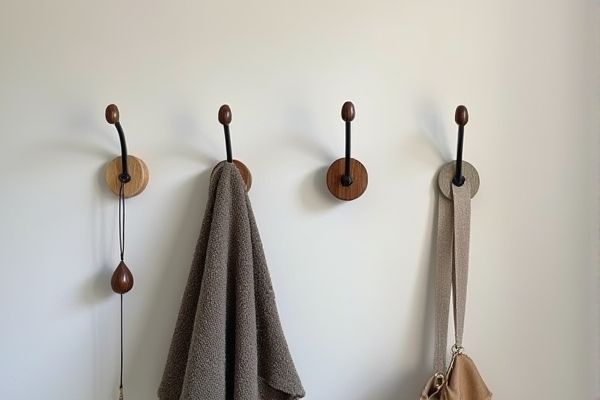
Wall hooks offer convenient storage solutions by maximizing vertical space on walls, ideal for hanging coats, keys, or bags, while ceiling hooks provide versatile mounting options for swings, plants, or lighting fixtures that require overhead support. Explore the article to discover which option best fits Your space and organizational needs.
Table of Comparison
| Feature | Wall Hooks | Ceiling Hooks |
|---|---|---|
| Installation Location | Mounted on vertical walls | Mounted on horizontal ceilings |
| Weight Capacity | Typically supports lighter to medium loads (5-50 lbs) | Supports heavier loads (10-100+ lbs), ideal for hanging plants, swings |
| Common Uses | Hanging coats, keys, pictures, utensils | Hanging plants, lighting fixtures, swings, hammocks |
| Installation Requirements | Drilling into drywall, studs preferred for strength | Secure attachment to joists or beams required |
| Visibility | Highly visible, decorative options available | Less visible, typically hidden among ceiling features |
| Space Utilization | Utilizes wall space effectively | Maximizes vertical space, frees floor and wall space |
Introduction to Wall Hooks and Ceiling Hooks
Wall hooks and ceiling hooks serve distinct purposes in organization and space optimization, with wall hooks typically used for hanging items such as coats, bags, and keys on vertical surfaces, offering easy accessibility and space-saving benefits. Ceiling hooks, installed on overhead surfaces, are ideal for suspending plants, lighting fixtures, or decorations, maximizing vertical space usage without occupying wall area. Choosing between wall hooks and ceiling hooks depends on the specific application, weight capacity requirements, and available mounting surfaces.
Functional Differences Between Wall and Ceiling Hooks
Wall hooks provide convenient access for hanging items like coats, bags, and keys at eye level or near entryways, ensuring easy reach and organization. Ceiling hooks are designed for suspending heavier or larger objects such as plants, lighting fixtures, or swings, offering vertical space utilization without cluttering walls or floor areas. Your choice between wall and ceiling hooks depends on the type of item you need to hang and the spatial arrangement required.
Common Uses for Wall Hooks
Wall hooks are commonly used for hanging coats, bags, keys, and decorative items, providing easy access and organization in entryways, bedrooms, and kitchens. These hooks are ideal for distributing weight evenly on vertical surfaces without damaging ceilings or requiring complex installation. You can maximize space efficiency by choosing wall hooks designed for specific items like hats, umbrellas, or cookware.
Typical Applications for Ceiling Hooks
Ceiling hooks are commonly used for suspending plants, hanging light fixtures, and securing decorations in indoor and outdoor spaces. Their vertical mounting design provides strong support for heavy objects like swings, hammocks, and storage nets. Ideal for maximizing floor space, ceiling hooks enable efficient organization in homes, garages, and workshops.
Installation Methods: Wall vs Ceiling Hooks
Wall hooks typically require drilling into studs or drywall anchors for secure mounting, ensuring stability for hanging items like coats or keys. Ceiling hooks are installed by anchoring into ceiling joists or using toggle bolts to support weight safely, ideal for hanging plants or light fixtures. Both methods require specific tools such as drills, screws, and anchors tailored to the surface and load capacity.
Material and Design Variations
Wall hooks and ceiling hooks differ significantly in material and design variations to suit their respective mounting surfaces and load requirements. Wall hooks often use heavy-duty metals like stainless steel or brass with decorative designs for aesthetic appeal and durability on vertical surfaces. Ceiling hooks are typically made from strong materials such as galvanized steel or aluminum, featuring threaded bases or toggle systems to ensure secure load-bearing capacity when anchored overhead.
Space Optimization: Which Hook Serves Better?
Wall hooks maximize space by utilizing vertical surfaces, ideal for hanging coats, bags, or keys without occupying floor area. Ceiling hooks excel in rooms with limited wall space, offering a versatile solution for hanging plants, lighting, or storage baskets from above. You can optimize your room layout efficiently by choosing ceiling hooks for overhead storage and wall hooks for accessible everyday items.
Weight Capacity and Durability Comparison
Wall hooks typically support weights ranging from 10 to 50 pounds depending on the material and installation method, while ceiling hooks can often bear heavier loads up to 75 pounds or more when anchored properly into ceiling joists. Durability varies with material composition; steel or heavy-duty metal ceiling hooks generally outperform plastic or lightweight wall hooks in resisting bending and wear over time. Proper selection based on load requirements and mounting surface ensures optimal performance and longevity for both types of hooks.
Aesthetic Impact in Home Decor
Wall hooks offer a versatile and visually appealing option for home decor by blending seamlessly with various interior styles, often serving as decorative accents that enhance wall textures and colors. Ceiling hooks create a unique vertical dimension, ideal for hanging plants, lighting fixtures, or art pieces, adding an element of sophistication and spatial interest without crowding wall space. Choosing between wall and ceiling hooks depends on the desired aesthetic effect, functional needs, and the architectural features of the home.
Choosing the Right Hook for Your Needs
Wall hooks provide sturdy support for hanging items like coats, bags, and decorations, making them ideal for spaces with solid walls such as drywall or wood. Ceiling hooks are perfect for suspending plants, lighting fixtures, or hanging chairs, especially when you need overhead attachment points and have appropriate ceiling joists or beams. Selecting the right hook depends on the weight capacity required, mounting surface, and intended use to ensure safety and functionality in your space.
 homyna.com
homyna.com